Quad strain rehabilitation focuses on restoring strength, flexibility, and function after injury. Early mobilization, isometric exercises, and progressive strengthening are key to a successful recovery process.
1.1 Understanding Quad Strains
A quad strain refers to an injury affecting the quadriceps muscles, which are crucial for knee extension and straightening; Strains occur due to sudden muscle contractions, overstretching, or direct trauma. Symptoms include pain, swelling, and difficulty in movements like walking or climbing stairs. Severity varies, with mild strains (Grade 1) causing minimal discomfort, while severe cases (Grade 3) involve complete muscle tears. Proper rehabilitation is essential to restore strength, flexibility, and function, preventing long-term weakness or chronic issues. Understanding the injury’s nature and severity is the first step toward effective recovery and returning to normal activities or sports.
1.2 Importance of Rehabilitation Exercises
Rehabilitation exercises are vital for recovering from quad strains, as they promote healing, restore function, and prevent future injuries. These exercises strengthen the quadriceps, hamstrings, and surrounding muscles, improving knee stability and reducing pain. Early mobilization enhances blood flow, minimizing scar tissue and stiffness. Strengthening and stretching routines also improve flexibility and mobility, essential for returning to daily activities or sports. Consistency in rehabilitation ensures a full recovery, helping individuals regain their strength and confidence. Without proper rehab, the risk of chronic weakness or recurring injuries increases, making a structured exercise program indispensable for achieving long-term recovery and maintaining optimal muscle function.
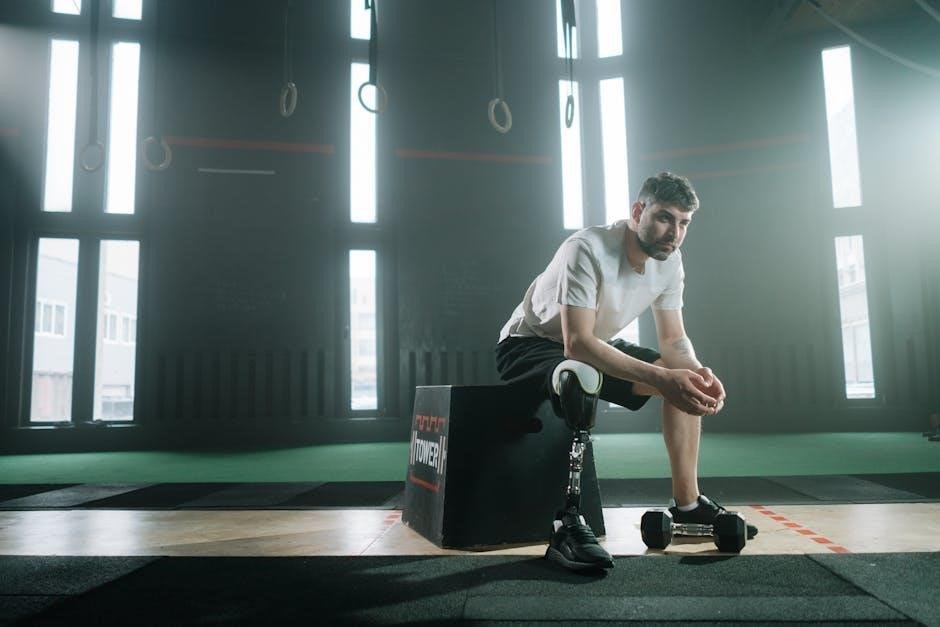
Initial Treatment and Management
Initial treatment focuses on reducing pain and inflammation through the PRICE protocol, followed by gentle mobilization and isometric exercises to maintain muscle activation without causing further damage.
2.1 PRICE Protocol (Protection, Rest, Ice, Compression, Elevation)
The PRICE protocol is crucial in the initial phase of quad strain recovery. Protection involves avoiding activities that stress the injured muscle. Rest is essential to prevent further damage. Ice should be applied for 15-20 minutes every 1-2 hours to reduce swelling. Compression using an elastic bandage helps minimize inflammation, while elevation of the affected leg above heart level promotes blood flow and reduces swelling. Adhering to this protocol during the first 48-72 hours ensures optimal healing conditions and minimizes the risk of complications, setting the foundation for effective rehabilitation.
2.2 Pain Management Strategies
Pain management is critical during the initial stages of quad strain recovery. Cryotherapy, such as ice packs, helps reduce swelling and discomfort. Nonsteroidal anti-inflammatory drugs (NSAIDs) can alleviate pain and inflammation. Gentle exercises, like ankle pumps, improve blood flow without aggravating the injury. Compression bandages and elevation further support pain relief by minimizing swelling. It’s important to balance rest with controlled movements to avoid stiffness. Pain should not be entirely avoided but managed to allow gradual progression in rehabilitation. Proper nutrition, including magnesium supplements, also aids in muscle recovery and pain reduction, ensuring a smoother transition to strengthening exercises.
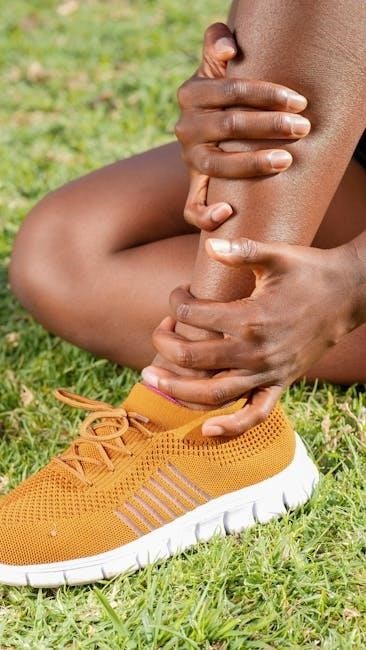
Acute Phase Rehabilitation
The acute phase focuses on pain management and swelling reduction. Immediate care includes rest, ice, and compression. Gentle mobilization begins to prevent stiffness and promote healing.
3.1 Immediate Post-Injury Care
Immediate post-injury care focuses on reducing pain and inflammation. The PRICE protocol—Protection, Rest, Ice, Compression, and Elevation—is essential during the first 24-48 hours. Apply ice for 15-20 minutes every 1-2 hours to minimize swelling. Use compression bandages or sleeves to support the muscle. Elevate the leg above heart level to reduce swelling. Avoid activities that worsen pain. Pain management may include NSAIDs or cryotherapy. Gentle mobilization can begin once acute pain subsides, but avoid aggressive movements. Early intervention sets the foundation for a successful rehabilitation process and prevents further damage. Rest is critical to allow the muscle to heal properly.
3.2 Early Mobilization Techniques
Early mobilization is crucial to prevent stiffness and promote healing. Gentle exercises like straight leg raises and heel slides help maintain range of motion without overloading the muscle. Avoid activities that cause pain or limping. Techniques such as passive stretching and joint mobilizations can enhance flexibility. Use resistance bands for low-intensity movements to gradually strengthen the quadriceps. Mobilization should progress slowly, ensuring the muscle can tolerate the activity. Proper form and technique are essential to avoid re-injury. Early movement stimulates blood flow, reducing muscle atrophy and promoting recovery. Always consult a healthcare professional to tailor exercises to the severity of the strain.
3.3 Isometric Exercises for Quad Activation
Isometric exercises are essential for activating the quadriceps without joint movement, making them ideal for the acute phase of recovery. Quad sets, where the back of the knee is pressed into the floor, help re-establish muscle control. Straight leg raises, performed while lying down, strengthen the quadriceps without bending the knee. These exercises improve muscle activation, reduce atrophy, and prepare the muscle for more dynamic movements. Start with multiple short contractions, gradually increasing duration as strength improves. Avoid pain during these exercises, as discomfort can hinder progress. Consistency is key to restoring quad function and setting the foundation for advanced rehabilitation phases.
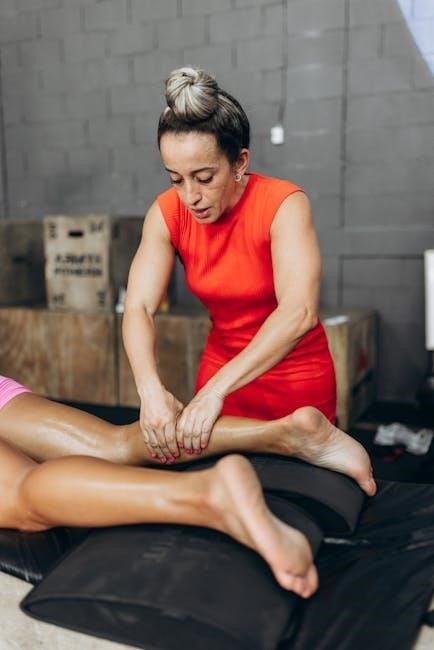
Early Strengthening Exercises
Early strengthening focuses on rebuilding quad muscle endurance and strength through controlled movements. Exercises like quad sets and straight leg raises are foundational for restoring function and progressing to more dynamic activities.
4.1 Quad Sets and Straight Leg Raises
Quad sets and straight leg raises are foundational exercises in early rehab. Quad sets involve contracting the quadriceps without moving the leg, improving muscle activation and strength. Straight leg raises focus on lifting the leg while keeping the knee straight, enhancing muscle control and endurance. These exercises are low-impact, reducing stress on the knee joint while promoting healing. They are typically performed in multiple sets throughout the day to gradually build strength and prepare the muscle for more advanced movements. Consistency and proper form are crucial to maximize benefits and prevent further injury. These exercises help restore normal muscle function and flexibility effectively.
4.2 Hamstring and Calf Stretching
Hamstring and calf stretching is essential for maintaining flexibility and promoting recovery. Tightness in these muscle groups can strain the quadriceps, so regular stretching helps reduce tension. Standing hamstring stretches involve bending forward at the hips, reaching for the toes, and holding for 20-30 seconds. Calf stretches can be done against a wall, leaning forward to stretch the Achilles tendon. These exercises improve circulation, reduce muscle stiffness, and support overall lower limb mobility. Consistent stretching routines prevent imbalances and enhance the effectiveness of quad-focused rehabilitation. Incorporating these stretches into daily routines ensures a balanced recovery and prepares the body for more demanding exercises.
4.3 Ankle Pump Exercises for Blood Flow
Ankle pump exercises are simple yet effective for improving blood circulation, which is crucial during quad strain recovery. By gently flexing and extending the foot, these movements help prevent swelling and promote healing. Patients are often advised to perform 10-15 repetitions every hour, especially in the acute phase. Enhanced blood flow delivers oxygen and nutrients to injured tissues, accelerating the repair process. Regular ankle pumps also reduce the risk of complications like phlebitis. This low-impact activity is easy to incorporate into daily routines, making it a vital component of a comprehensive rehabilitation program focused on restoring strength and mobility to the quadriceps.

Stretching Exercises for Flexibility
Stretching exercises enhance flexibility and prevent stiffness, crucial for quad strain recovery. Techniques include standing and lying quad stretches, promoting muscle length and balance effectively.
5.1 Standing Quad Stretch
The standing quad stretch is a fundamental exercise for improving flexibility in the quadriceps. To perform this stretch, stand with one hand against a wall for balance. Bend one knee, keeping the foot behind you, and gently pull your heel toward your buttocks. Hold this position for 20-30 seconds, ensuring you feel a stretch in the front of your thigh. Maintain proper posture and avoid arching your back. Repeat on the other side. This exercise helps restore range of motion, reduces muscle tension, and promotes healing in the early stages of quad strain rehabilitation. Consistency is key for optimal results.
5.2 Lying Quad Stretch
The lying quad stretch is an effective way to improve flexibility while minimizing strain on the knee. Lie on your side with your injured leg on top. Bend your top knee and grab your ankle or foot with one hand. Gently pull your heel toward your buttocks until you feel a stretch in the front of your thigh; Hold for 20-30 seconds, breathing deeply to relax the muscle. Repeat on the other side. This stretch is particularly beneficial for those with limited mobility, as it can be done without putting weight on the knee. Regular practice enhances flexibility and reduces muscle tension.
Intermediate Phase Rehabilitation
The intermediate phase focuses on progressing strength and mobility through controlled exercises. Step-ups and balance training enhance functional movements, while resistance band workouts strengthen the quadriceps without overloading the knee. These activities promote stability and prepare the muscle for more dynamic tasks, reducing the risk of future injuries.
6.1 Step-Ups and Balance Training
Step-ups and balance training are essential in the intermediate phase of quad strain rehab. Step-ups target the quadriceps, hamstrings, and glutes, improving functional strength and knee stability. Start with a low platform, ensuring proper alignment of the knee over the second toe. Gradually increase height as strength improves. Balance exercises, such as single-leg stands or wobble board work, enhance proprioception and reduce injury risk; These exercises promote neuromuscular control, preparing the knee for dynamic movements. Progressing step height and incorporating resistance bands can further challenge strength and stability. Consistency in these exercises ensures a smooth transition to more advanced rehabilitation phases, fostering long-term knee health and function.
6.2 Resistance Band Workouts
Resistance band workouts are versatile tools in quad strain rehabilitation, offering controlled resistance to strengthen the quadriceps and surrounding muscles. They are lightweight, portable, and adaptable to varying strength levels. Start with low resistance and gradually increase as strength improves. Exercises like banded leg presses, straight leg raises, and lateral walks target specific muscle groups. These workouts enhance muscle endurance and promote proper movement patterns. Resistance bands are particularly effective for isolating the quadriceps without overloading the knee joint. Incorporate them into your routine to progressively challenge muscle strength and support a smooth return to activity. Consistency with these exercises accelerates recovery and builds resilience against future injuries.

Advanced Strengthening Exercises
Advanced strengthening exercises, such as leg presses and lunges, focus on rebuilding power and endurance. These dynamic movements prepare the quadriceps for high-demand activities and sports.
7.1 Leg Press and Lunges
Leg press and lunge exercises are essential for advanced strengthening in quad strain rehabilitation. The leg press targets the quadriceps, hamstrings, and glutes, promoting balanced lower limb strength. Start with single-leg presses to isolate the quadriceps and gradually increase resistance. Lunges enhance functional movement, improving balance and coordination. Perform walking or stationary lunges, ensuring proper form to avoid additional strain. These exercises mimic real-life movements, preparing the individual for dynamic activities. Incorporate them into your routine 2-3 times weekly, progressing resistance as strength improves. Proper technique is crucial to maximize benefits and prevent further injury. These exercises are key for returning to high-level activities and sports.
7.2 Agility Drills for Return to Sport
Agility drills are crucial for transitioning back to sports after a quad strain, enhancing speed, balance, and directional changes. Incorporate exercises like zigzag running, cone drills, and shuttle runs to mimic sports-specific movements. Start with low-intensity drills and progress as strength and confidence improve. Proper form and technique are essential to avoid re-injury. these drills improve functional movement and reaction time, preparing the body for dynamic activities. Perform agility exercises 2-3 times weekly, allowing for recovery between sessions. This phase focuses on restoring power and explosiveness, ensuring a safe and effective return to competitive sports.
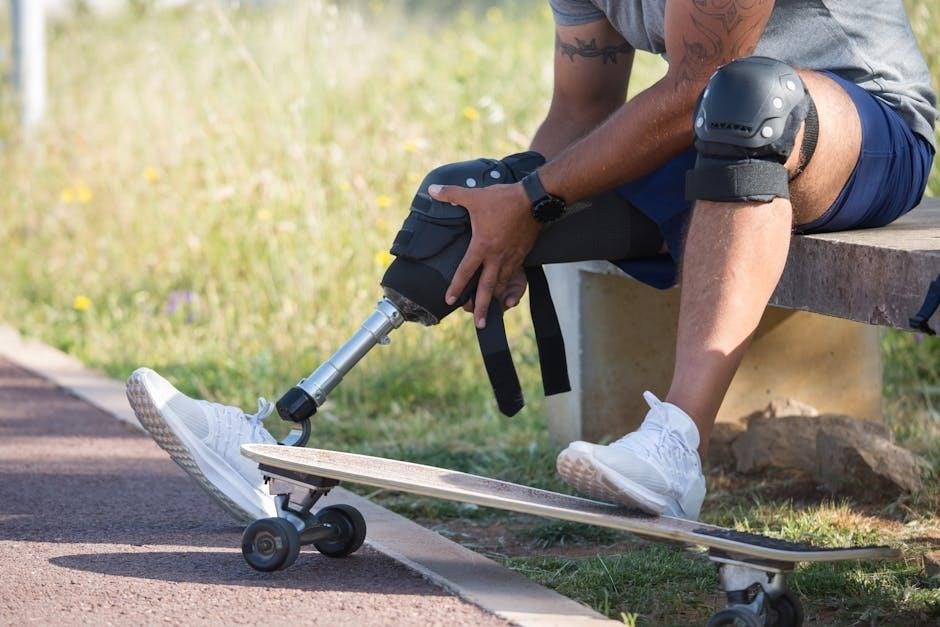
Prevention of Future Strains
Preventing future quad strains involves strengthening surrounding muscles, improving flexibility, and incorporating proper warm-up routines. Consistent training and avoiding overloading are key to long-term muscle health and injury prevention.
8.1 Strengthening the Surrounding Musculature
Strengthening the muscles around the knee, such as hamstrings, glutes, and calves, is essential for preventing future quad strains. Weakness in these areas can lead to poor movement patterns and increased stress on the quadriceps. Exercises like leg presses, lunges, and step-ups target these muscle groups, improving overall lower limb stability. Incorporating resistance training with bands or weights can also enhance strength and resilience. Consistency in these routines helps maintain proper muscle balance, reducing the risk of re-injury. Proper form and gradual progression are key to ensuring effective and safe strengthening.
8.2 Flexibility and Mobility Routines
Regular flexibility and mobility exercises are crucial for preventing quad strains by improving muscle elasticity and joint range of motion. Incorporating static stretches, such as standing and lying quad stretches, helps lengthen tight muscles. Dynamic stretches, like high knees and leg swings, enhance mobility before activity. Additionally, foam rolling and self-myofascial release can reduce muscle tension and improve circulation. Consistent practice of these routines ensures muscles remain supple, reducing the risk of strains. Balancing flexibility with strength training creates a robust foundation for injury prevention, allowing for optimal performance in daily activities and sports.
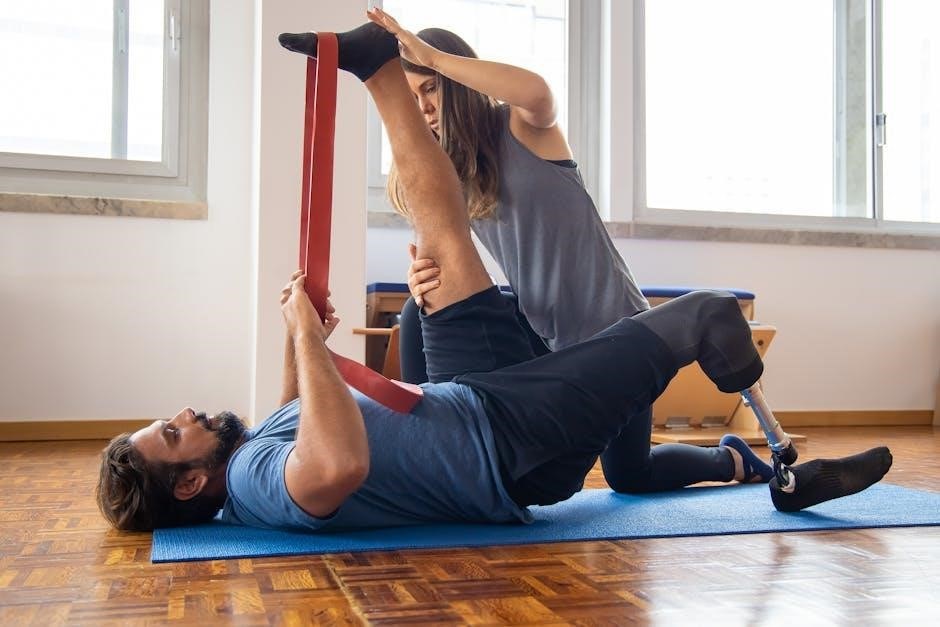
Common Mistakes to Avoid
Avoid overloading too early, as it can lead to re-injury. Ignoring proper form and technique may hinder recovery and cause further muscle imbalances or strain.
9.1 Overloading Too Early
Overloading too early is a common mistake that can prolong recovery. Muscles need time to heal, and excessive stress can lead to re-injury. Gradually increase intensity and focus on controlled movements. Avoid activities that cause sharp pain or discomfort, as this signals overexertion. Listen to your body and follow a structured rehab plan. Rushing back to full activity can undermine progress and delay return to normal function. Patience is crucial to ensure proper healing and long-term strength.
9.2 Ignoring Proper Form and Technique
Ignoring proper form and technique during rehabilitation can hinder progress and increase the risk of re-injury. Poor execution may lead to ineffective exercises or even further muscle damage. Always prioritize correct movement patterns to ensure the targeted muscles are engaged properly. Using improper form can also delay healing and reduce the effectiveness of the rehab program. It is essential to follow guidance from healthcare professionals or physical therapists to maintain optimal technique. Consistency and attention to detail are key to a successful recovery and preventing future strains. Proper form ensures safety and maximizes the benefits of each exercise in the rehabilitation process.

The Role of Nutrition in Recovery
Nutrition plays a crucial role in muscle repair and recovery. Adequate protein intake supports tissue healing, while magnesium aids in muscle function and relaxation, promoting overall recovery efficiency.
10.1 Protein Intake for Muscle Repair
Adequate protein intake is essential for muscle repair during quad strain recovery. Protein provides the building blocks for tissue repair, promoting collagen synthesis and muscle fiber regeneration. Aim for 1.2-1.6 grams of protein per kilogram of body weight daily. Sources like lean meats, fish, eggs, dairy, and plant-based options are ideal. Timing is also crucial; consuming protein within an hour post-workout and before bed can enhance recovery. Additionally, protein shakes can be a convenient supplement to meet daily requirements, ensuring muscles receive the necessary nutrients to heal and strengthen effectively after a strain.
10.2 Magnesium Supplements for Muscle Function
Magnesium plays a crucial role in muscle function and recovery, particularly during quad strain rehabilitation. It helps regulate muscle contractions and relaxations, reducing cramps and spasms. Magnesium also supports energy production by aiding ATP synthesis, which is essential for muscle repair. Athletes and individuals with quad strains often benefit from magnesium supplements to enhance recovery and prevent deficiencies. The recommended daily intake is 400-420 mg for men and 310-320 mg for women. Foods rich in magnesium, such as dark leafy greens, nuts, and whole grains, should be included in the diet. Consulting a healthcare provider before starting supplements is advised to ensure proper dosage and safety.
Quad strain rehabilitation is a comprehensive process that combines rest, strengthening, and flexibility exercises to restore muscle function. Early phases focus on managing pain and avoiding overloading, while later stages incorporate resistance training and agility drills. Proper nutrition, including protein and magnesium, supports muscle repair. Consistency and adherence to a structured program are key to preventing future injuries and achieving full recovery. By following a well-rounded approach, individuals can effectively rehabilitate their quadriceps and return to normal activities or sports with improved strength and mobility.
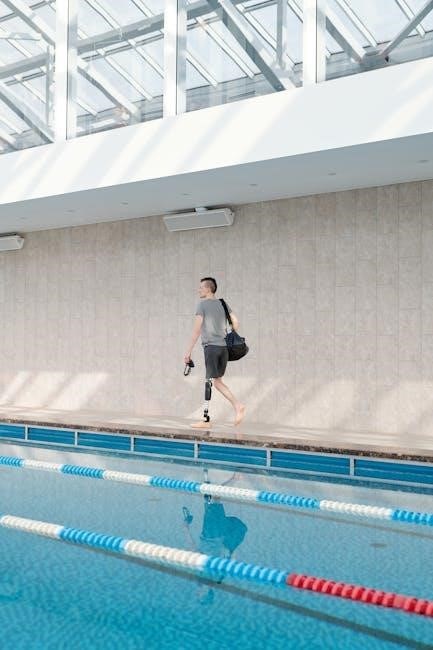
Additional Resources
For further guidance on quad strain rehabilitation, consider exploring the following resources:
- Knee Resilience Program for structured exercise plans.
- Quadriceps Tendinopathy Rehab Blog for detailed insights and tips.
- Sports Medicine Websites for evidence-based recovery guidelines.
- Physical Therapy Guidelines for professional exercise recommendations.
- Exercise Databases for visual demonstrations of rehab exercises.
These resources provide comprehensive support for a successful recovery journey.
Comments